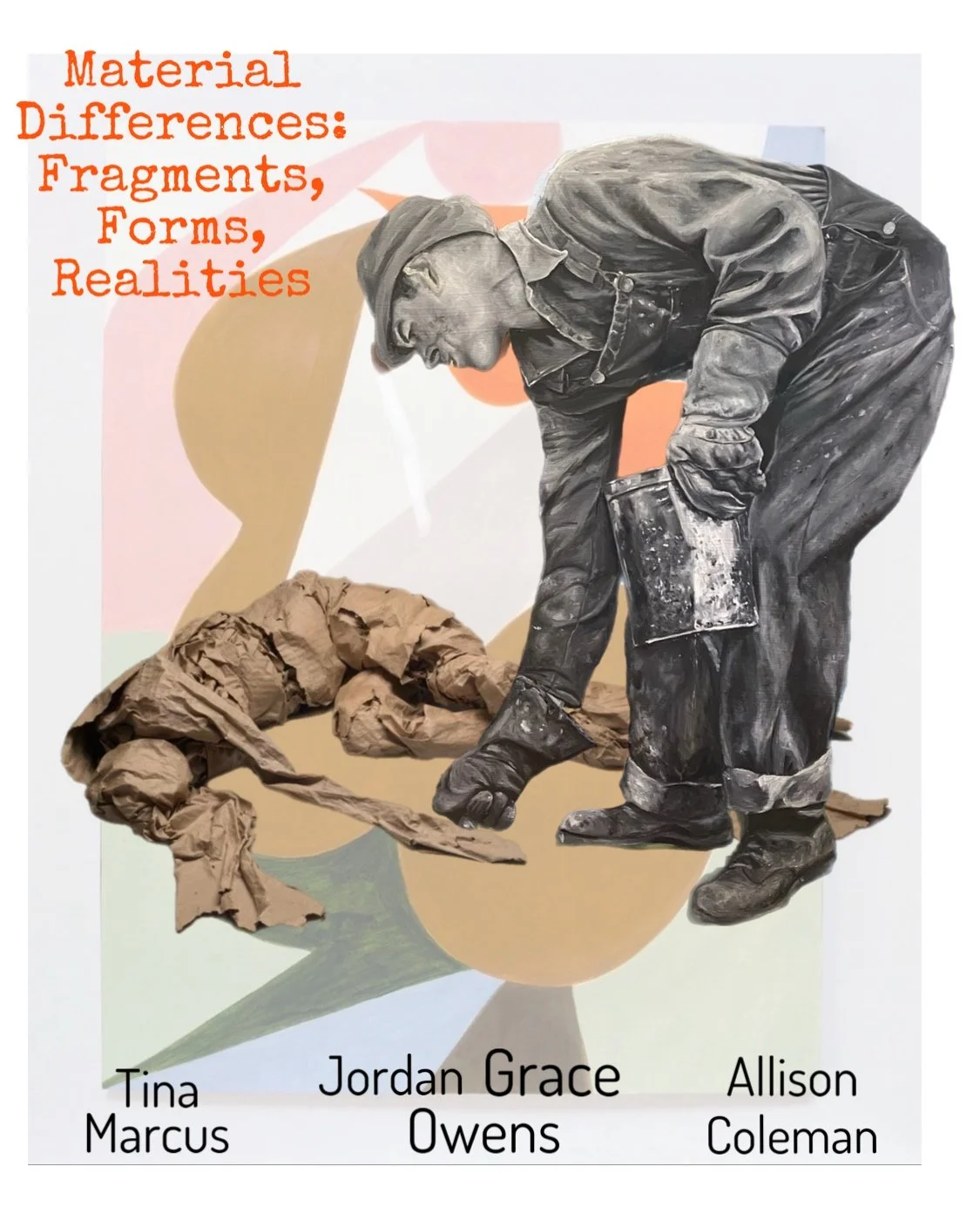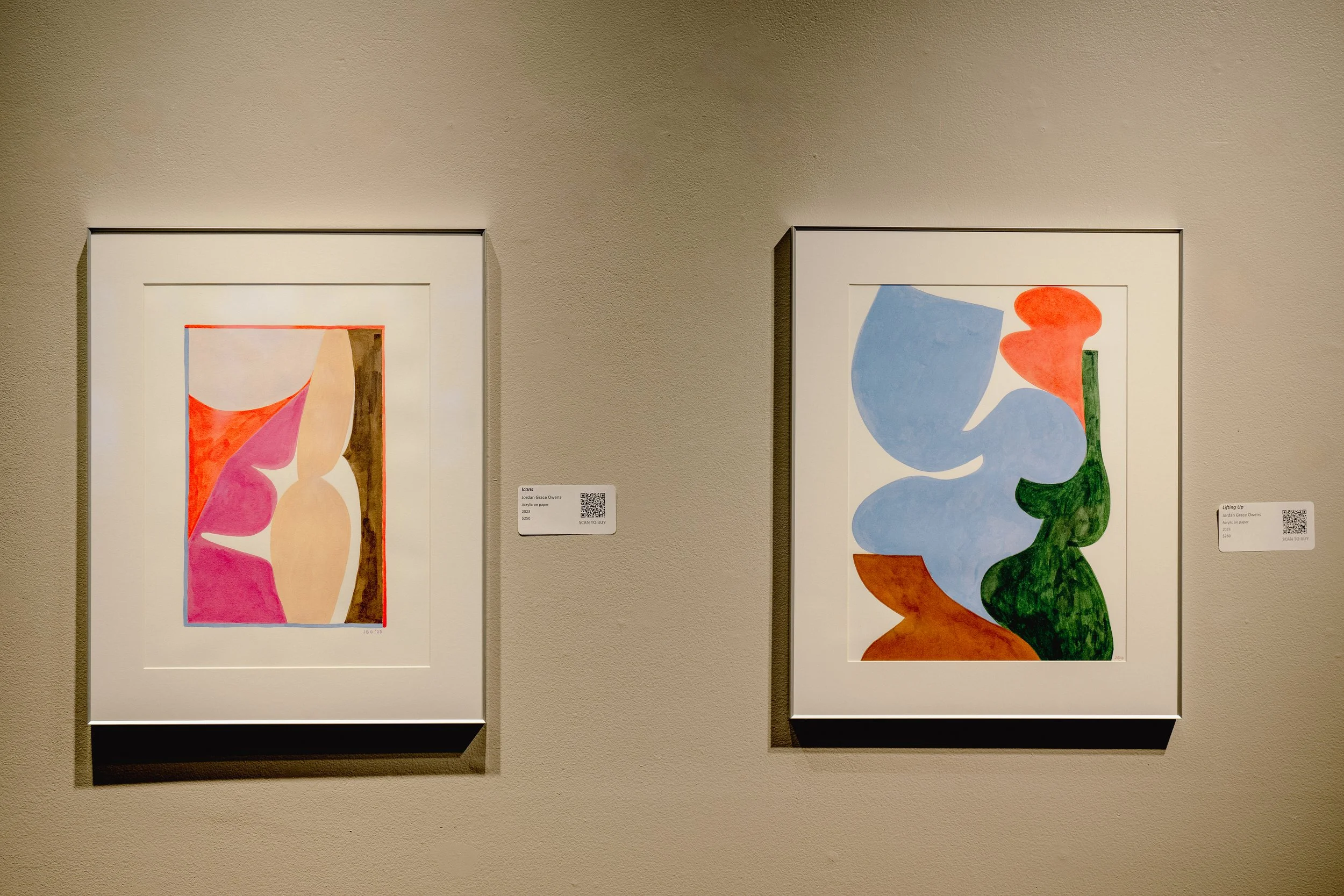Material Differences: Fragments, Forms, Realities
Featuring Allison Coleman, Tina Marcus, Jordan Grace Owens
DAG Truist Gallery | January 19 to March 10, 2024
Artists Statement
Fragments, shapes, and figures are woven into narratives that are graphic and playful, socially and politically charged in the dynamic work of Jordan Grace Owens, Allison Coleman, and Tina Marcus.
The work of these artists brings together three artists who, despite their distinct approaches to materials, converge in their dedication to the figurative form. Through their individual practices, they delve into the essence of humanity, each employing unique materials and techniques to capture the essence of the human experience.
Jordan Grace Owens uses paint, sewn canvas, and wooden constructions to explore a fluidity of physical form and a complexity of maternal autonomy.
Allison Coleman creates dreamlike worlds with oil paint, exploring the narrative through pigment and texture. Thin washes of paint signify the deterioration of human memory and the passage of time and bold strokes explore ideas of permanence and urgency.
And in Tina Marcus’ work she incorporates the ordinary material of cardboard paper in her figurative sculptures to express soul-stirring narratives of ambiguity, and relationships between resilience and vulnerability.
About Jordan Grace Owens
My work explores a fluidity of physical form through fragmented figures and shifting, relational abstract shapes. Using multiple mediums including paint, sewn canvas, and cut wood, I’m interested in exploring design, materiality, and the intersections between two-dimensional and three-dimensional planes.
My interest in figure builds upon my decade-long career in portrait illustration. After having two children and shifting into the challenging new paradigm of artist/young mother, I began focusing on studio work in earnest. I was inspired by the surreality of my own changing physical form, as well as the intensely bodily relationships between myself and my young children. In my work, undulating organic shapes suggest the unreliability of physical boundaries. Shapes press against, fold around, and intersect one another, reflecting the complexity of maternal autonomy. The negative spaces created by these relationships are treated with as much importance as the shapes themselves. In further effort to explore a fluidity of form, much of my work straddles categories of two- and three-dimensions. My wooden paper dolls are primarily two-dimensional, but they are playfully inserted into a viewer’s three-dimensional space, suggesting the potential for actual physical movement and even inviting viewers to touch and interact with them. It’s important to me to imbue a sense of movement into all of my compositions, creating undercurrents of temporality and flux.
About Tina Marcus
Paper it is ordinary, mundane and it is embedded in our lives. We package, store, transport, consume and discard it and we assume it is always accessible; until it is not. Paper is integral in my work and its messages, as it underscores how fragile life can be revealing a relationship between resilience and vulnerability; the experiences of being human.
My work documents snapshots of defining thought-provoking moments I experience, witness, and think about. The cardboard paper material I use is something we use every day; it is unremarkable and common, and we take for granted it is always there. While common expressions describe each work, these
narratives are ambiguous. Paper’s perishable characteristics encourages viewers to peel away layers into each work narratives and to consider: what happens to these paper sculptures or society when subjected to adverse factors? Will these paper figures, or we, deteriorate or persevere? If subjects do not deteriorate does this indicate issues will not go away. Or could this mean people are more resilient and able to overcome obstacles and endure? Or have we become overexposed and desensitized to issues and just not care. With every nook, cranny and paper fold, my work is not to dehumanize; rather they are open vessels exposing life and experiences. Imperfections within each story reveal there is beauty within us and even within the frailties of life.
About Allison Coleman
Allison Coleman’s narrative paintings are a reflection on her fascination with the past and her concern for the present. Using the cheerful imagery of the 1950s and 60s she creates a sense of longing and nostalgia , while also acknowledging the darker realities that existed just beneath the surface. Through painting, she highlights how vantage points can both quell our fears and bolster our positions. Using storytelling and pictorial devices such as scale and perspective, with a vivid color palette, Allison warps image and memory into an interwoven power dynamic. Her paintings teeter between comforting recollections and psychological distress, and space is given to the viewer so they may challenge their own viewpoints and lived experiences.
Interested in the enigmatic and the absurd, these paintings both confront and celebrate. Dream- like worlds and faded memories merge to become representations of the human condition. Just like in life, cherished memories and deep seated fears exist side by side. Ultimately, her work strikes a balance between the past and the present, acknowledging the challenges of the past while also celebrating the beauty and the resilience of the human spirit.














